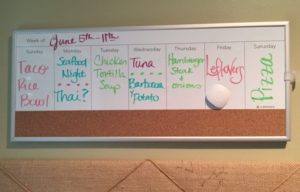What does every successful goal have?
A PLAN!
But I get it, it’s summer time and it’s difficult to work on improving your health right now. However, you’ll be less likely to fall completely off the bandwagon with simple meal planning. If you’ve never meal planned, check out these 4 super simple steps to get started!
Why Meal Plan?
It may seem like an inconvenience but in 10 mins or less per week meal planning can…
- Save money – In America we spend over $165 billion on food waste according to USA Today. That’s roughly $529 per person!
- Save time – when you meal plan less time is spent trying to figure out what to cook and it’s saves excess trips to the grocery store
- Save frustrations – see above, plus avoiding feeling crummy because you’ve been eating out too much
How to Meal Plan – 4 Easy Steps
Step 1 – Set the Foundation
- Make & keep a list of your family favorites – The average American’s only eat a variety of 12-15 different foods. Think about it, breakfast is typically 2-3 different options, typical lunch 3-4 options and dinner may have a bit more variety but is usually is around 5-7 for most people & families.
- Think back of old food/recipe favorites – compile them and write them down. Keep the list on the fridge for all to see or in your phone so you won’t lose the list!
- Ask your family – why should 1 person do all the thinking? Ask your family what they like. This way too you’ll know most everyone will like the meals on the meal plan.
- Set a day every week to make your menu (don’t add more to the to-do list) – Maybe on a Sunday or Saturday? Or whatever day works for you!
 My nifty weekly meal plan for all to see. I personally love this little board! (Found on Amazon.com)
My nifty weekly meal plan for all to see. I personally love this little board! (Found on Amazon.com)
Step 2 – Create the menu from your family favorites
- Keep it flexible & SIMPLE – Start with 1 week or 2 weeks, not a whole month – it may seem like an accomplishment but it’s unreasonable. It’s hard to predict on Sunday what will taste good on Wednesday, let alone 3 weeks away.
Always leave room for flexibility. Leave room for eating out. Plan meals for no more than 5 days – leave 1 day for leftovers & another for eating out or unpredictable days. - Sometimes less is more – It’s easy to bombard yourself with too many options (thank you, Pinterest 🙂 ). If you don’t have a lot of time on your hands, choose no more than 1 new recipe per week but keep most of your plan filled with familiar recipes. This way you know everyone likes them, you know how to make them quickly & you know how long they will last!
Step 3 – Make the Shopping List
- Check inventory – Do a quick basics inventory and add a few things here and there.
- Buy in bulk those spices, herbs, oils, vinegars you use a lot of!
- Write down only the items you need – remember that amount of money we waste on food every year? Approximately $529 per person! Keeping the list short with only the ingredients needed can dramatically reduce this number!
Step 4 – Shopping
- Stick to the plan! And don’t go to the store hungry. You’ll buy everything that looks good with the best intentions. Trust me, I know from experience.
- If there’s something on sale that you eat a lot of, sure – go for it!
- Never buy produce that you don’t have a plan for! – schedule a mid-week produce run, this run and breaking up the menu plan allows for flexibility and keeps the fridge from being overstocked with rotting veggies.
How to Set Up Your Plan
Breakfasts: Make breakfast the time when you have the most protein. Natural adrenal rhythms release cortisol upon waking up which raises blood glucose. So, having a carbohydrate loaded breakfast will only lead to a crash soon thereafter. Packing your breakfast full of protein fuels your body & gives you energy to tackle the day.
Lunches: Think protein and veggies, or leftovers to make it as simple as possible. This is the perfect time to get in your daily vegetable intake. Think salads, soups or stews. Make your lunch with lean protein, veggies & low glycemic carbs for lasting energy and again, to avoid that mid-day “I need a nap” feeling.
Dinners: To ensure adequate sleep, which is vital for healthy body function, make sure to include <2 servings of carbs at dinnertime. Sleep studies have found that people who tend to wake up during the night are waking up due to drops in their blood sugar. To avoid this and to help get a good night’s sleep, make sure to include 1-2 servings of carbs at dinnertime.
Snacks: Most snacks are eaten after lunch and before dinner. During this time a bit more carb is needed than recommended at lunch. Choose snacks that contain low glycemic carbs with protein.
Want a FREE healthy & delicious dietitian-approved meal plan to get you started?
How has meal planning helped you?
Let me know & follow me on Facebook!


